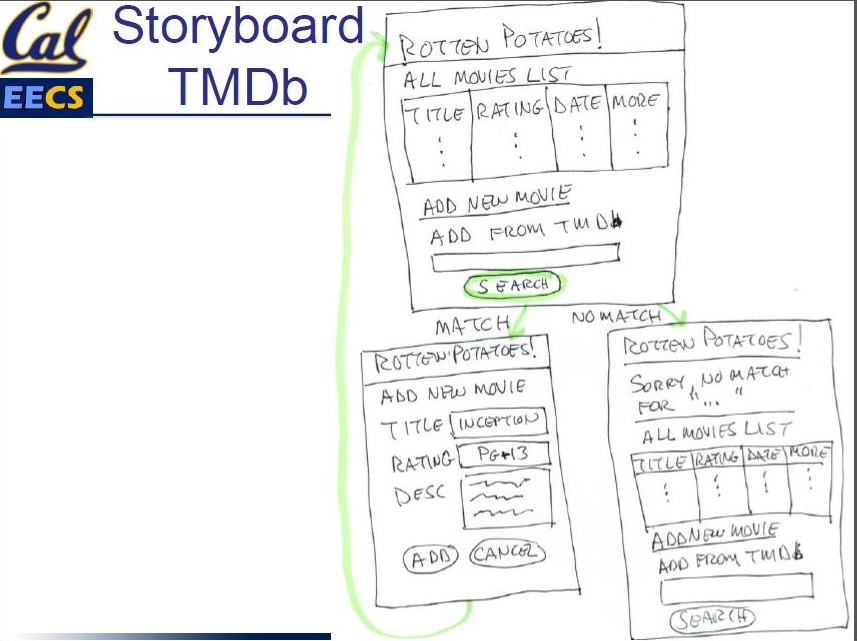CSC/ECE 517 Fall 2012/ch2a 2w26 aj
SaaS 4.6 Enhancing Rotten Potatoes again
Introduction
The article is intended to be an accompaniment to the SaaS video lecture 4.6 titled “Enhancing Rotten Potatoes again” <ref name="video">Enhancing Rotten Potatoes again, http://www.youtube.com/watch?v=2l9uLw3y6J8
</ref>, part of the SaaS video lecture series for the Software Engineering for SaaS hosted on the Coursera learning network. <ref>Coursera, https://www.coursera.org/</ref>
The Rotten Potatoes webpage, designed in the previous lectures is enhanced for implementing a new feature to add a new movie by looking up the TMDb database<ref> TMDb — The Movie Database, http://www.themoviedb.org/</ref> rather than manually entering the movie name. The flow of this article is as follows :
- The scope of discussion
- Brief description of the storyboard used for the Lo-Fi UI design discussed in previous lectures in the video lecture series,
- Explanation of Sad path, Happy Path and Bad Path
- Description of the User Story developed in the video lecture
- Elaboration of the test scenarios written for the particular User story (including scenarios for happy and sad paths) in Cucumber
- Explanation of the Background facility in Cucumber
Scope
The scope of this article is limited only to the scope covered in the video lecture. The lecture builds upon Behavior-Driven Development (BDD) basics discussed in the video lectures before it and sets the reader up for upcoming lectures concerning Test-Driven Development (TDD). Hence for the purpose of this article, it is assumed that the reader has already read the material and watched the video lectures before this one in the series. Hence the setup for Cucumber, Capybara and BDD basics are excluded from this article. The resources dealing with these can be found in the SaaS lectures 4.1 to 4.5 in the series. Similarly, the theory and implementation of TDD as well as further discussion on BDD is excluded from the scope of this article. More details on these can be found in lectures 4.7 to 5.11 of the SaaS lecture series .<ref>Software Engineering for SaaS, https://class.coursera.org/saas-2012-003/class/index </ref>
A Brief Recap
Behavior-Driven Development (BDD) is a specialized development process which concentrates more on the behavioral aspects of the application as against the actual implementation of the application. <ref>Software Engineering for SaaS, https://class.coursera.org/saas-2012-003/class/index </ref>
Storyboards are used to show how UI changes based on user actions. Even if it is tedious to draw sketches and storyboards, it helps build a ‘bigger picture’ understanding of the flow of the application for the non-technical stakeholders.
Cucumber is one of the shining tools of Rails that is used for testing purposes. It acts as a halfway between the customer and the developer by converting user stories of 3x5 cards into tests. These tests act as Acceptance tests for ensuring the satisfaction of the customer. Also, the tests act as Integration tests that ensures the communication between modules is consistent and correct
The User Story
The aim of the User story described in the video is to add a new feature to the Rotten Potatoes web page, to add a new movie to the movies list on Rotten Potatoes page. But, for adding the movie to the list, it populates the data from TMDb rather than entering the information by hand. This is aimed at reducing repetitive work since the TMDb already has a good database of movies. To do so, the ability to search TMDb from Rotten Potatoes home page needs to be incorporated in the webpage. Users can then search in TMDb if the movie is present in it and then its details can be imported into Rotten Potatoes. For integrating this feature into the application, first, a Lo-Fi UI and Storyboard is designed, which is described next.
The StoryBoard
The Storyboard is to be interpreted as follows When a person wants to add a new movie to the Movies list on Rotten Potatoes, he/she will enter the new movie name and click “Search”. The controller method should search the TMDb database for the given movie. If a match is found, i.e. the movie is present in the TMDb, then the “Match” page is displayed. If there is no match, otherwise “No Match” page is displayed. These two scenarios, are the Happy Path and Sad Path implementations respectively.

==Happy Path, Sad Path and Bad path <ref>http://www.nishantverma.com/2010/03/test-case-paths-happy-sad-bad.html </ref>== Many of us are aware of the test cases being categorized as Positive or Negative test cases. Similarly, for testing using Rails Cucumber, the tests cases are being categorized as Happy, Sad of Bad. A test case that results in a positive result is called a Happy Path. Ex. On entering correct username and password on login page, the application logs the user in. A test case that yields no result is called a Sad Path. Ex. Entering invalid username or password on login page, which normally returns an ‘Incorrect username or password’ message A test case to handle an exceptional condition or situation, which the system should handle elegantly and show some message to the user is a Bad Path. E.g. Uploading image size exceeds a limited amount. User can then take corrective action
Elaboration of the User Story
Let us consider the sad path scenario for the Search TMDb User Story Feature.
Feature: User can add movie by searching in The Movie Database(TMDb)
User Story:
As a movie fan
So that I can add new movies without manual tedium
I want to add movies by looking up their details in TMDb
Scenario: Try to add non-existent movie (sad path)
Given I am on the RottenPotatoes home page
Then I should see "Search TMDb for a movie"
When I fill in "Search Terms" with "Movie That Does Not Exist"
And I press "Search TMDb"
Then I should be on the RottenPotatoes home page
And I should see "'Movie That Does Not Exist' was not found in TMDb."
<references/>